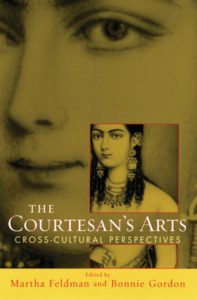
Cover image from oupcanada.com
From the Introduction
“The Indian courtesan pervades precolonial art, literature, mythology, texts on rituals, polity, pleasure, and law books in the three major religions founded on Indian soil. Yet as much as she captivates, she also eludes. Why? Because her actions, her character, her mystique, are relayed to us by outsiders to her world, or to traditional India. Her own voice has remained faint until fairly modern times. This essay introduces different voices that describe the Indian courtesan over a vast stretch of history. What becomes clear is that two options for power were open to the precolonial Indian woman: that of the sexually liberated and educated courtesan or the pure, sexually controlled, uneducated wife.”
Notes
- Though the introduction (perhaps misleadingly) focuses on the courtesan/wife binary, the main thrust of this chapter is that courtesans are the “keepers of culture” in precolonial India. The “Keepers of culture” concept is described as follows: “It was the courtesans who sustained high culture in Lucknow, the kingdom’s capital. They kept alive the distinctive manners of Lucknow society and were instrumental in the development of Kathak dance and Hindustani music.”
- Srivinasan focuses mainly on two types of pre-colonial Indian courtesans: ganika, secular and well-educated courtesans often associated with royal courts, and devadasis, courtesans dedicated to temples as God’s mortal wives.
- Srivinasan resists a one-dimensional view of courtesans by providing simple definitions of multiple types of courtesans and discussing differences in their access to education, their places of work, etc.
- Modern Western readers, who are often saturated in anti-sex-work images and ideologies that shame and criminalize prostitutes, may be interested to learn about the “high culture” expectations of the ganika: on page 162, Srivinasan outlines how the Kamasutra, arguably the most famous ancient book about human sexual behaviour, details over 60 arts in which a ganika should be proficient (including singing, dancing, decorating, tailoring, and even architecture); for mastering these arts, the ganika ought to receive “a seat of honour in the assembly of men”—the ability to discourse with men as their equal. Srivinasan also observes that the Artharashtra, an ancient text on Indian polity, regarded the ganika’s training as an investment of the state.
